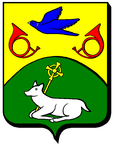Culey
| Culey | ||
|---|---|---|

|
|
|
| region | Grand Est | |
| Department | Meuse | |
| Arrondissement | Bar-le-Duc | |
| Canton | Vaucouleurs | |
| Community association | Bar-le-Duc Sud Meuse | |
| Coordinates | 48 ° 45 ' N , 5 ° 16' E | |
| surface | 11.02 km 2 | |
| Residents | 141 (January 1, 2017) | |
| Population density | 13 inhabitants / km 2 | |
| Post Code | 55000 | |
| INSEE code | 55138 | |
 Look at Culey |
||
Culey is a French commune with 141 inhabitants (as of January 1, 2017) in the Meuse department in the Grand Est region ( Lorraine until 2015 ); it belongs to the District Bar-le-Duc and the Association of Municipalities Bar-le-Duc Meuse Sud . The municipality was part of the canton of Ligny-en-Barrois until 2015 .
geography
Culey is located around 8 kilometers east-southeast of the small town of Bar-le-Duc in the south of the Meuse department. The place is on the Ruisseau de Culey . Large parts of the municipality are forested.
Neighboring municipalities are Érize-Saint-Dizier in the northeast, Loisey in the east, Tronville-en-Barrois in the southeast, Silmont in the southwest, Longeville-en-Barrois and Resson in the west and Naives -Rosières in the northwest.
history
Like all parishes in the area, the parish suffered from conflict in the Middle Ages. The worst devastation was caused by the Hundred Years War and the Thirty Years War . The name of today's municipality was first mentioned in a document in 709 under the Latin name Quala . In the Middle Ages, the community belonged to the Barrois mouvant and was part of the Champagne . It was subordinate to the Kastlanei Pierrefitte in the Bailliage Bar. From 1793 to 1801, Culey belonged to the District of Bar-sur-Ornain (today Bar-le-Duc). From 1793 to 1801 it was in the canton of Loisey. From 1801 to 2015 Loisey was part of the canton of Ligny-en-Barrois . The municipality has been assigned to the Arrondissement of Bar-sur-Ornain (today Bar-le-Duc) since 1801. From 1973 to July 1, 2014, it was united with the neighboring municipality of Loisey to form the municipality of Loisey-Culey.
Population development
Despite its proximity to the small town of Bar-le-Duc, the rural exodus was as pronounced as in many small communities in France. The population shrank from the high in 1821 to 1982 by 74.3 percent. After a period of strong growth between 1946 and 1962, a new wave of emigration followed until 1982.
| year | 1793 | 1821 | 1846 | 1896 | 1946 | 1962 | 1968 | 1975 | 1982 | 1990 | 1999 | 2006 | 2011 | 2016 |
| Residents | 478 | 490 | 440 | 243 | 157 | 220 | 197 | 154 | 126 | 143 | 156 | 157 | 155 | 146 |
| Sources: Cassini and INSEE ; Figures for 1975 to 2011: INSEE - Populations communales pour chaque recensement de 1876 à 2015 | ||||||||||||||
Attractions
- Saint-Mansuy village church
- Sainte-Geneviève chapel in the Forêt Domaniale de Sainte-Geneviève in the north of the municipality
- Memorial to the fallen in the village cemetery
- Three wayside crosses; at the village cemetery, on the road to Loisey and the Croix Saint-Aupre north of the village
- Former watermill on Ruisseau de Culey
traffic
In terms of transport, the community is a few kilometers north of Route nationale 4 with the next connection in Ligny-en-Barrois. The D6 and N135 are important for regional traffic.
The railway line from Nancy to Bar-le-Duc, which is served by TER Lorraine , passes a few kilometers to the west and south of the municipality . Closest stops are Bar-le-Duc and Nançois-Tronville.
literature
- Le Patrimoine des Communes de la Meuse. Flohic Edition, Paris 1999, ISBN 2-84234-074-4 .






